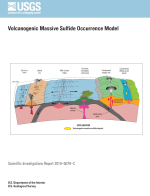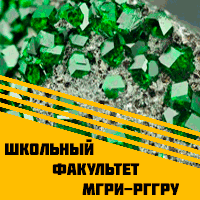Добрый день, Коллеги. Важное сообщение, просьба принять участие. Музей Ферсмана ищет помощь для реставрационных работ в помещении. Подробности по ссылке
Volcanogenic massive sulfide occurrence model / Модель вулканогенного залегания массивных сульфидов
Volcanogenic massive sulide (VMS) deposits, also known as volcanic-hosted massive sulide, volcanic-associated massive sulide, or sealoor massive sulide deposits, are important sources of copper, zinc, lead, gold, and silver (Cu, Zn, Pb, Au, and Ag). These deposits form at or near the sealoor where circulating hydrothermal luids driven by magmatic heat are quenched through mixing with bottom waters or porewaters in near-sealoor lithologies. Massive sulide lenses vary widely in shape and size and may be podlike or sheetlike. They are generally stratiform and may occur as multiple lenses.
Volcanogenic massive sulide deposits range in size from small pods of less than a ton (which are commonly scattered through prospective terrains) to supergiant accumulations like Rio Tinto (Spain), 1.5 Bt (billion metric tons); Kholodrina (Russia), 300 Mt (million metric tons); Windy Craggy (Canada), 300 Mt; Brunswick No. 12 (Canada), 230 Mt; and Ducktown (United States), 163 Mt (Galley and others, 2007). Volcanogenic massive sulide deposits range in age from 3.55 Ga (billion years) to zero-age deposits that are actively forming in extensional settings on the sealoor, especially mid-ocean ridges, island arcs, and back-arc spreading basins (Shanks, 2001; Hannington and others, 2005). The widespread recognition of modern sealoor VMS deposits and associated hydrothermal vent luids and vent fauna has been one of the most astonishing discoveries in the last 50 years, and sealoor exploration and scientiic studies have contributed much to our understanding of ore-forming processes and the tectonic framework for VMS deposits in the marine environment. Massive ore in VMS deposits consists of >40 percent sulides, usually pyrite, pyrrhotite, chalcopyrite, sphalerite, and galena; non-sulide gangue typically consists of quartz, barite, anhydrite, iron (Fe) oxides, chlorite, sericite, talc, and their metamorphosed equivalents. Ore composition may be Pb-Zn-, Cu-Zn-, or Pb-Cu-Zn-dominated, and some deposits are zoned vertically and laterally.
Many deposits have stringer or feeder zones beneath the massive zone that consist of crosscutting veins and veinlets of sulides in a matrix of pervasively altered host rock and gangue. Alteration zonation in the host rocks surrounding the deposits are usually well-developed and include advanced argillic (kaolinite, alunite), argillic (illite, sericite), sericitic (sericite, quartz), chloritic (chlorite, quartz), and propylitic (carbonate, epidote, chlorite) types (Bonnet and Corriveau, 2007).
An unusual feature of VMS deposits is the common association of stratiform “exhalative” deposits precipitated from hydrothermal luids emanating into bottom waters. These deposits may extend well beyond the margins of massive sulide and are typically composed of silica, iron, and manganese oxides, carbonates, sulfates, sulides, and tourmaline. <...>




